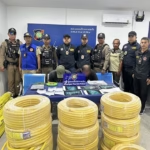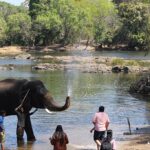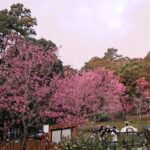Morning mist curls around terraced hills in Chiang Rai. A few hours later, a barista in Bangkok lifts a kettle, and a bright, citrusy pour-over fills the room. That quick jump from farm to café sums up the magic of Thailand’s Specialty Coffee in 2025.
Specialty Coffee means high-quality Arabica, traceable farms, careful roasting, and skilled brewing. It is grown with intent, processed with care, and served with craft. The market is hot right now. Quality cups under 100 baht are easy to find.
Bangkok specialty coffee sales are surging, provincial scenes are thriving, and Thailand’s coffee market is worth about 65 billion baht in 2025, up roughly 8.3 percent year over year. This guide shows where beans come from, where to drink, how to plan a coffee trip, and what to buy.
Chiang Rai’s High-Altitude Arabica: How Specialty Coffee Starts
Why does Chiang Rai matter so much for Thailand coffee? Cool air, high elevation, and farming skill. These hills give clean, sweet cups with vivid aromas. In 2025, farmers focus on single-origin lots, organic practices, shade trees, water-saving methods, and tight traceability. Climate shifts add stress, but selective picking, smarter processing, and better drying keep quality high.
Expect Chiang Rai Arabica to taste like honey, citrus, and floral notes, with light chocolate and a tea-like body. If you see jasmine, orange zest, or brown sugar on the bag, you are in the right zone. Look for labels that list the variety, altitude, process, and roast date. Details signal care from field to cup.
For a deeper background on how local communities fuel this rise, explore the story of Chiang Rai’s hill tribe specialty coffee boom.
Why Elevation and Microclimate Shape Flavor
High elevation slows cherry growth. Slower growth builds sugars and complex acids, which translate to clarity and sweetness in the cup. Shade protects cherries from heat spikes. Rich soil and cool nights help beans develop structure and bright yet balanced flavors. You taste that balance as a layered, juicy acidity that is never sharp.
This is the heart of Specialty Coffee, made simple. Healthy plants, patient ripening, clean harvests, and precise processing create better flavors.
Sustainable and Ethical Farming in 2025
Drinkers want organic and traceable beans. Farmers respond with shade-grown coffee that protects birds, improves soil health, and keeps moisture in the ground. Fair prices and training raise quality and stability. When farmers can invest in drying beds, water filters, and sorters, defects drop and flavor improves.
When you buy, choose traceable lots and smallholders paid fairly. Your cup tastes better, and the farm thrives.
From Cherry to Cup: Processing That Lifts Quality
Processing can change flavor as much as variety. Here is a simple guide you can taste.
| Process | How it works | Taste cues |
|---|---|---|
| Washed | Fruit removed, beans washed, then dried | Clean and bright, citrus and floral, tea-like body |
| Honey | Some fruit was left on during drying | Honeyed sweetness, round body, gentle fruit |
| Natural | Whole cherries dried, fruit removed after | Bold fruit, jammy sweetness, heavier body |
Careful drying and sorting keep defects low, so flavors pop. Ask cafés which process they are serving for Chiang Rai beans. It helps you pick the profile you like.
How to Read a Thai Coffee Bag
What to scan in seconds:
- Origin: Chiang Rai, plus farm or village name
- Altitude: higher usually means brighter acidity and sweeter finish
- Variety: Typica, Catimor, Bourbon, Caturra, or local hybrids
- Process: washed, honey, or natural
- Roast date: fresher is better, aim for within 30 days
- Tasting notes: use as a guide, not a rule
Buy in small amounts. Drink while fresh. Store away from heat and light.
Bangkok and City Scenes: Hip Specialty Coffee Spots to Try in 2025
Bangkok is buzzing. Specialty coffee growth is strong, and many quality cups still land under 100 baht. Big chains hold broad market share, but indie cafés drive Specialty Coffee forward with single-origins, new brew methods, and signature drinks. Younger customers push for better taste, real stories, and sustainable choices.
Want a practical example of accessible quality? One to Two Coffee is a solid pick for value-focused specialty drinks with multiple locations, steady quality, and clear menus. Then branch out to local indie cafés that rotate Chiang Rai single-origin lots. Ask for seasonal offerings and pour-over recommendations.
Curious how Chiang Rai is reaching the global stage? See how events and farm visits are elevating producers in Chiang Rai’s push to global coffee hub status.
Affordable Quality: Great Cups Under 100 Baht
Value fuels demand. Even as prices rise elsewhere, you can still find stand-out cups without breaking your budget.
Try these:
- Hand-brewed pour-over, usually from Chiang Rai or another northern origin
- Espresso with milk, balanced and sweet, great with lighter roasts
- Seasonal cold brews, refreshing and aromatic
Tip: look for daily single-origin features or a small tasting flight. Comparing two Chiang Rai processes side by side teaches your palate quickly.
What Makes a Hip Café in 2025
A good café is more than a pretty cup.
- Open brew bars invite questions and learning
- Clear filter menus show origins, processes, and brew methods
- Light snacks, clean design, and calm spaces welcome work or chat
- Latte art adds fun, but real freshness and skill make the cup
- Friendly barista chat about origin and process builds trust
If a barista lights up when you ask about drying beds or roast curves, you are in the right place.
Spotlight: One to Two Coffee and Indie Gems
One to Two Coffee keeps specialty accessible, with consistent espresso, clear flavor notes, and fair prices. It is a good entry point if you are new to single-origin Thai coffee. From there, branch out to indie shops that rotate Chiang Rai lots. The smaller the batch, the more the story shows in the cup.
Ask baristas about the roast level and water ratio for the house beans. Good shops share details. Great shops invite you to taste them.
Ready-to-Drink and New Formats
Busy day, no problem. Ready-to-drink cans and bottles are growing fast in city fridges. Look for labels that name the origin and list tasting notes. Avoid vague blends if you want true Specialty Coffee character.
Quick tips:
- Choose RTD with a clear roast or production date
- Prefer cold chain storage for flavor stability
- Pick the Chiang Rai single-origin cold brew if you want citrus and floral notes on the go
Plan a Thailand Specialty Coffee Trip: Chiang Rai to Bangkok
Start up north, finish in the city. That is the easy route for a coffee-focused trip. Visit a farm or community mill in Chiang Rai, then fly or take the overnight train to Bangkok for café hopping and roastery tours. Plan for mornings, since baristas are fresh and bakeries are stocked. And yes, the best croissant and pour-over combo usually hits before noon.
Timing matters. Fresh-crop releases follow harvest and processing cycles. Cooler months give clearer views and easier travel days in the hills.
Best Time to Go and What to Expect
- Go in the cooler months for farm visits, open skies, and comfortable hikes
- Fresh-crop coffee often appears a few months after harvest and processing
- Pack a light jacket for mornings in the mountains, and plan early starts
A 3-Day Chiang Rai Coffee Trail
- Day 1: visit a community wet mill, learn picking basics, and taste washed vs natural beans
- Day 2: join a cupping with a local roaster, then buy a small bag to bring to Bangkok
- Day 3: catch a sunrise viewpoint, grab a pour-over at a local café, then travel to the city
Budget, Etiquette, and Easy Thai for Coffee
Budget
- Expect many great café cups under 100 baht
- Set aside extra for bags of beans and transport
Etiquette
- Order at the counter, bus your tray
- Ask before filming or photographing staff
- Be patient during rush hours, especially on weekends
Useful Thai phrases
- “ga-fae ron” means hot coffee
- “yen” means cold
- “mai waan” means not sweet
How to Pack and Store Beans on the Road
- Buy whole beans, not pre-ground, for better flavor
- Keep bags sealed, avoid heat and sunlight
- Choose one-way valve bags to release gas without letting in air
- Grind only what you need before brewing
- If flying, carry beans in your hand luggage to avoid cargo heat
Buy, Brew, and Trends: Make the Most of Specialty Coffee in 2025
Thailand’s coffee market hit about 65 billion baht in 2025, up around 8.3 percent. Specialty is a small slice by value, roughly 2 billion baht per year, yet it is the fastest-growing part with around 25 percent growth. Bangkok leads café openings, while Chiang Rai drives origin quality. Put those pieces together at home with a smart buy and a simple brew plan.
Smart Buying: Labels, Freshness, and Price
Quick checklist:
- Origin: Chiang Rai
- Altitude: higher often equals brighter, sweeter cups
- Process: washed, honey, or natural, matched to your taste
- Roast date: within 30 days is ideal
- Tasting notes: a helpful guide, not a promise
Price guides
- Cafés: Value cups under 100 baht are common
- Beans: fair retail prices for a 200 to 250 gram bag depend on variety and process; expect to pay a bit more for traceable lots with careful processing
Choose traceable, ethically sourced beans when you can. Your money supports quality at the farm level.
Easy Home Brewing That Tastes Café-Quality
You do not need fancy gear. A burr grinder, a simple dripper, a kettle, filtered water, and a basic scale do the job.
Brewing ratios:
- Start with 1:15 to 1:17 coffee to water by weight for pour-over
- Example: 15 grams of coffee to 250 grams of water for a small cup
Troubleshooting:
- Sour taste means under-extracted, grind finer or brew longer
- Bitter taste means over-extracted, grind coarser, or brew faster
- If the cup is flat, try hotter water or a slightly higher dose
A small log of your brews helps you dial in fast.
Trends to Watch in 2025
- Strong specialty demand in Bangkok, with rising interest across provinces
- More single-origin releases from northern Thailand, including limited lots from Chiang Rai
- Creative RTD lines with origin stories and tasting notes
- Simple apps and subscriptions that ship traceable beans to your door
- Story-driven menus that show farm, process, and harvest date
Behind the scenes, Thailand increased coffee imports in 2025 due to strong demand. Local production of specialty beans is growing, but not fast enough to fill every cup yet. That gap also pushes roasters to value Thai lots when they can get them.
Support Farmers and Independent Roasters
- Buy direct when possible, then share feedback with roasters
- Attend cuppings, learn about climate challenges, and ask how you can help
- Choose traceable lots and pay a little more for quality that returns value to the farm
Small choices add up. That steady support helps communities keep planting shade trees, improve drying beds, and train the next generation of growers.
Conclusion
Thailand’s coffee story flows in a clear line. Chiang Rai farms grow the beans, city cafés showcase them, and you taste the journey in every cup. Keep a few ideas close: value cups under 100 baht exist, single-origin Chiang Rai shines with citrus and honey, and simple home steps bring café-quality flavor within reach.
Ready to sip the story? Plan a weekend coffee trail, try a Chiang Rai pour-over this week, and pick one bag of traceable beans to back local growers. Share your favorite café or farm visit so others can find it too. The scene is moving fast, and Specialty Coffee in Thailand is only getting better.














